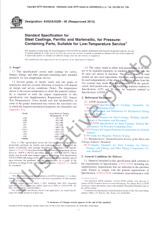We need your consent to use the individual data so that you can see information about your interests, among other things. Click "OK" to give your consent.
ASTM D8052/D8052M-22
Standard Test Method for Quantification of Air Leakage in Low-Sloped Membrane Roof Assemblies
Translate name
STANDARD published on 1.8.2022
The information about the standard:
Designation standards: ASTM D8052/D8052M-22
Publication date standards: 1.8.2022
SKU: NS-1083925
The number of pages: 8
Approximate weight : 24 g (0.05 lbs)
Country: American technical standard
Category: Technical standards ASTM
The category - similar standards:
Annotation of standard text ASTM D8052/D8052M-22 :
Keywords:
air, air flow, air leakage, flow, flow meter, laboratory method, membrane, negative pressure, pressure, roof, wind pressure,, ICS Number Code 91.100.50 (Binders. Sealing materials)
Additional information
| Significance and Use |
|
5.1?This test method can be useful in understanding the response of low-sloped membrane roof assemblies to air pressure differences induced across the assembly. 5.2?This test method can be useful in understanding the role of different roofing components in providing resistance to air leakage through the roof assembly. 5.3?When applying the results of tests by this test method, note that the performance of a roof or its components, or both, depends on proper installation. 5.4?This test method does not purport to establish all criteria necessary for the consideration of air movement in the design of a roof assembly. Air intrusion in roofing systems is separate and distinct from air leakage in roofing systems. Test Method D7586/D7586M provides an air intrusion test method for mechanically attached roof assemblies. The results are intended to be used for comparison purposes and likely do not represent the field-installed performance of the roof assembly. |
| 1. Scope |
|
1.1?This test method provides a laboratory technique for determining air leakage in low-sloped membrane roof assemblies under specified negative air pressure differences. 1.2?This test method is intended to measure air leakage of a roof assembly with rooftop penetrations. 1.3?The values stated in either SI units or inch-pound units are to be regarded separately as standard. The values stated in each system may not be exact equivalents; therefore, each system shall be used independently of the other. Combining values from the two systems may result in nonconformance with the standard. 1.4?This standard does not purport to address all of the safety concerns, if any, associated with its use. It is the responsibility of the user of this standard to establish appropriate safety, health, and environmental practices and determine the applicability of regulatory limitations prior to use. 1.5?This international standard was developed in accordance with internationally recognized principles on standardization established in the Decision on Principles for the Development of International Standards, Guides and Recommendations issued by the World Trade Organization Technical Barriers to Trade (TBT) Committee. |
We recommend:
Technical standards updating
Do you want to make sure you use only the valid technical standards?
We can offer you a solution which will provide you a monthly overview concerning the updating of standards which you use.
Would you like to know more? Look at this page.




 Cookies
Cookies
